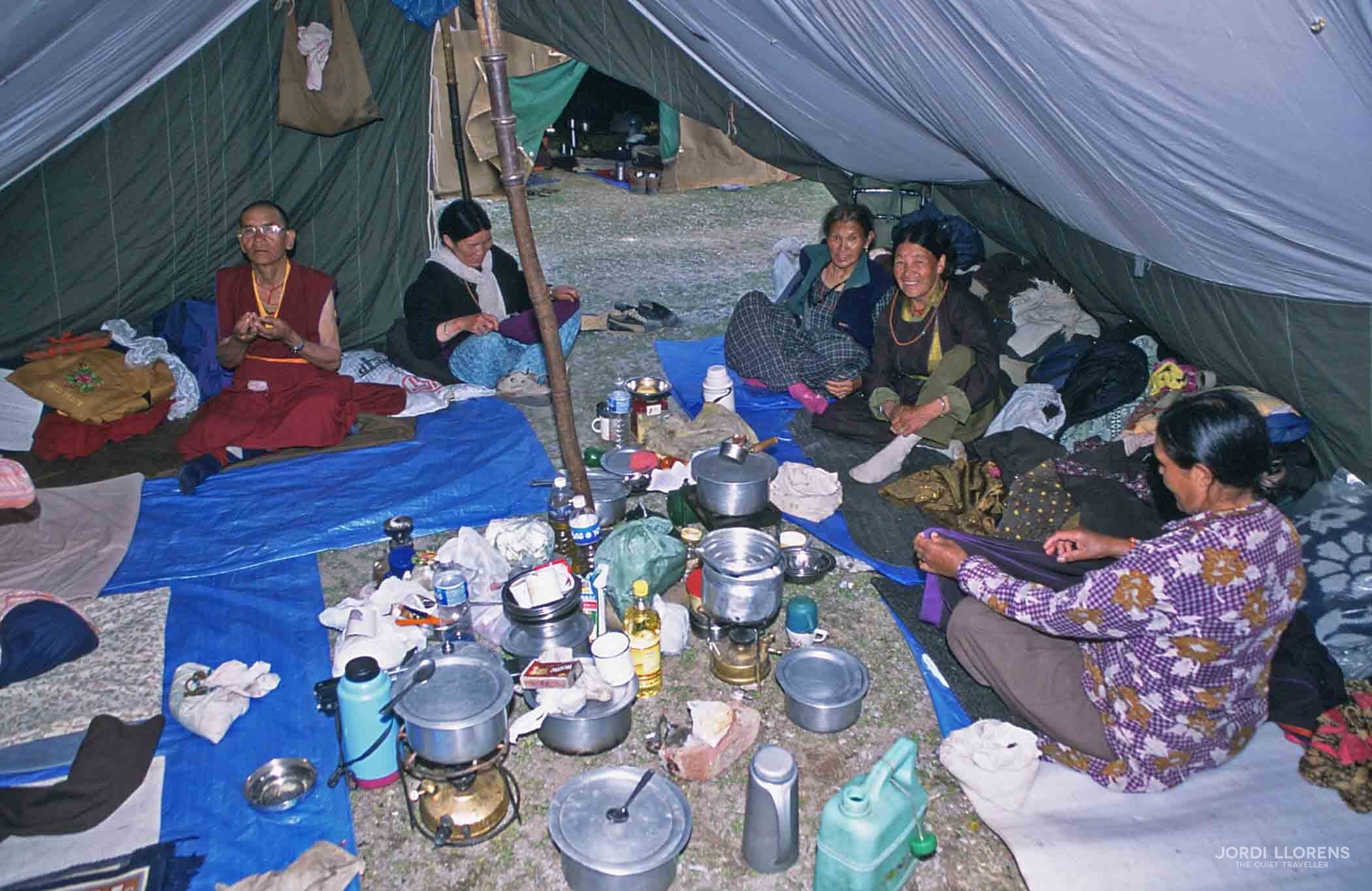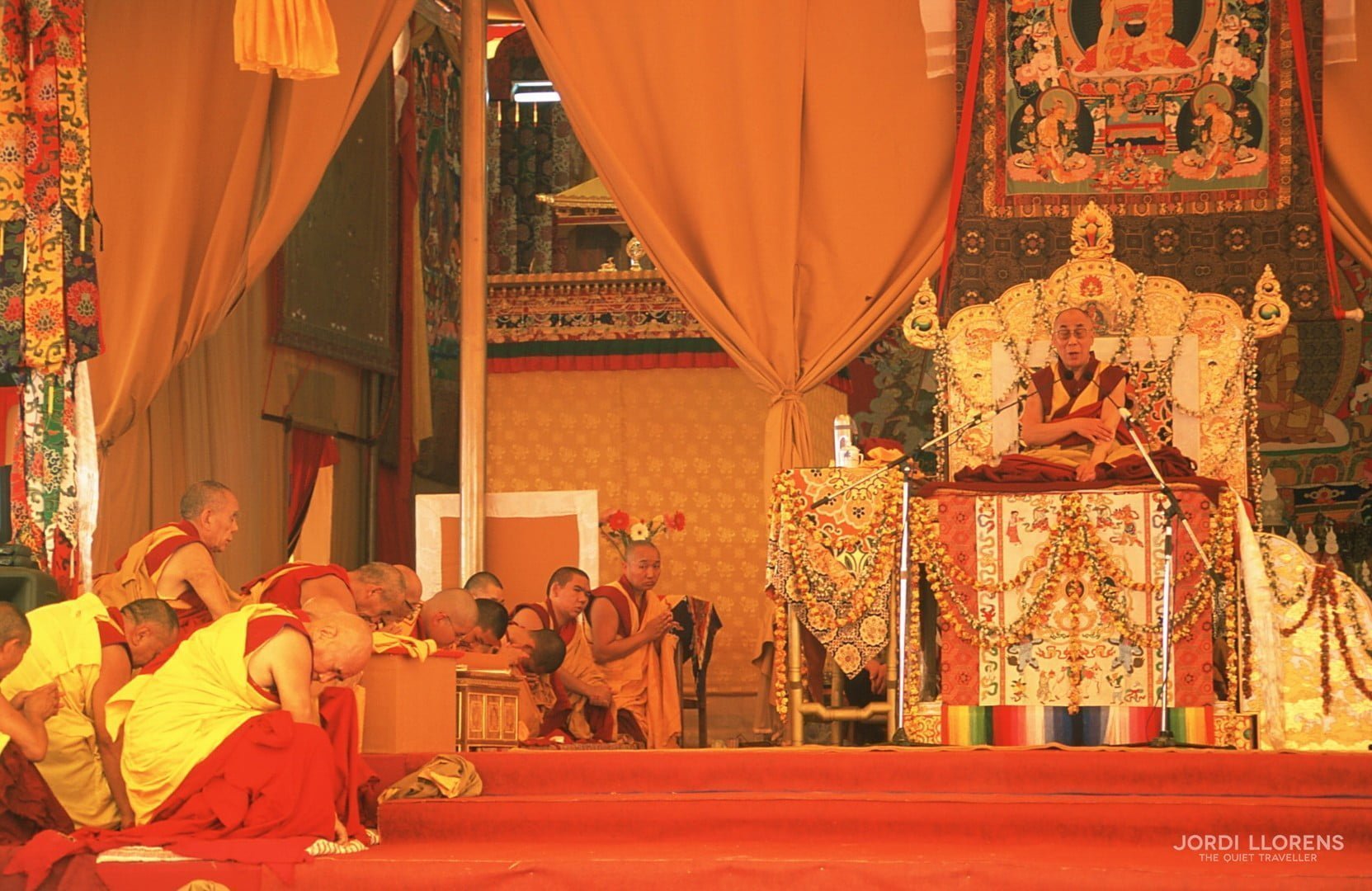The journey started at the House of Tibet in Barcelona, when its director, Wangchen, asked me to do a photo report to visit the Tibetan refugee camps in South India and attend the Kalachakra ceremony held by the Dalai Lama.
AMARAVATI
Amaravati is located in southern India, in the state of Andhra Pradesh. It is a small rural village near the Krishna River, where its inhabitants are predominantly Hindi.
Amaravati was chosen because it is the place where 2,500 years ago, the Buddha gave his first Kalachakra and it is done every 4 years. It is the largest Buddhist ritual for peace and tolerance, the only Tibetan Buddhism initiation ceremony that the Dalai Lama conducts for a large audience.
Suddenly, this town increased its population by 200,000 people, who had come from all over the world to attend such an event. They were all concentrated on the main street, which turned into a human swarm. But the biggest nightmare for me was the loudspeakers that were at a considerable volume, from 8 in the morning until dusk, without interruption.
But within the chaos, they were still well organized. Pollution made us to wear a mask on the street, this being a product highly requested by pilgrims.
Traders from other parts of India had come here to sell their products; even the Tibetans sold their own handicrafts and took advantage to claim free Tibet.

Sellers from all over the country
This concentration of people brought beggars from all over the country, some of them with significant physical deformations.

Beggars and physically disabled begging for alms
ACCOMMODATION
But you will wonder how to accommodate so many people? The city was organized in camps of different types: comfort, luxury, for Tibetans, Ladakhs, police, firemen, and etc. Sixty-six hectares of land had to be occupied for its construction.
My camp was one km from the big tent where the teachings were given. They were groups of tents together, separated only by fabric walls, which provided an intimate space of its own, although difficult to get, since you could hear everything. But it was kept fairly clean due to the daily spraying of the camp.

My private space in the camp
The toilets and showers were separate and a vegetarian food restaurant.
Instead, simpler were the pilgrims’ camps, which had been out of their homes in the Himalayas for months. And those of the monks, who had rented houses where they could

Pilgrims camp
HEALTH
Despite the prevailing chaos, the organization had everything planned. If someone got sick, there was always a doctor available and a nearby hospital. But it was my turn to get sick. Yes, when I had been in the camp for a few days I began to feel ill in such a way that they took me to a kind of hospital or medical centre where they took blood and diagnosed me malaria. I was stunned as I was taking prophylaxis. They gave me some pills wrapped in newspaper and a few days later I was back on track to continue living the ceremony.
THE BIG TENT
For the place of the ceremonies they built a big tent to accommodate the hundreds of thousands of pilgrims who were going to participate in the Buddhist ritual.

Buddhists from all over the world
And the stage where the Dalai Lama was located represented a Buddhist temple. Around 50 monks accompanied him for the sacred rituals, as well as event sponsors such as members of the Japan Bushokai Foundation, the Norbulingka Institute in Dharamsala and the Andhra Pradesh government.

Stage where the Dalai Lama is located
The Dalai Lama began the program with prayers and conducted the meeting in Tibetan, saying that the Buddha’s teachings were relevant to today’s modern world; the message was translated into English and several languages, which listeners followed through small transistors.
The inside of the tent was divided into sections where the press, foreigners, sponsors, Tibetans, Hindus, monks, VIPS were located … In many cases, because they were so far from the stage, a closed circuit television had been installed to get a closer look at the Dalai.
Europeans, Americans, Australians, Japanese … the entire Buddhist world had come to this little place. Thinking about the effort made by the people of Ladakh, Tibet, Sikkim, Bhutan, Mongolia …, to get here, most of them dressed in their best clothes.

Different ethnicities with their best dresses
Everywhere there were many security controls, but since I had a press card, I had complete freedom to move wherever I wanted but without stepping on the stage, only accessible to a few.
Due to the high temperatures, the teachings were done in the morning and ceremonies were held in the afternoon without the Dalai. I was impressed by the mantras recited by monks and lamas in a hoarse voice.

Dalai Lama devotees
But to add colour to the event, the best were the elaborate costumes of the monks of the Namgyal monastery who performed a ritual dance as part of the Kalachakra preliminaries.

Namgyal monastery monks
The heat and the exhaustion took their toll on the pilgrims, who adopted comical postures that were difficult to maintain if not sleeping.

Having a rest
At the end of the day’s teachings, I had free afternoons to visit the city, take photos in the streets or go to the press centre, the coolest place in all of Amaravati.
While pilgrims spent their free time on a large esplanade, where there was the largest stupa in India built during the 3rd century BC, the Mahastupa, which contains the relics of the Buddha and where Buda gave the first teachings of the Kalachakra. During the day they would entertain themselves by prostrating themselves in front of the great stone slab or they would do the kora, which is to turn around the great stone.

Stupa Mahastupa, containing the relics of Buddha
And at night there was the fair, as I call it, where there was fun and night theatre, with a cultural program of mainly Indian dances and music.
Again the day began with long queues to get the best place inside the big tent.

Long lines to get in
The Dalai, while making his offerings and small ceremonies where the monks of the Dharamsala monastery participated, often asked that the message of love and peace be spread through inter-religious dialogue.
All attendees to the event always very attentive to what their spiritual leader was doing. I was passionate to see on their faces the expressions of emotion that emanated from within them.

Faith and devotion to the Dalai Lama
MANDALA
Kalachakra means “wheel of time” in Sanskrit. It is a complex cycle of tantric teachings that belongs to the highest of yoga. During the 10 days that the ceremony lasted, the monks made a sand mandala with enormous precision and concentration, whose final destination was to be destroyed and thrown into the moving water to symbolize the ephemeral nature of everything around us. Kalachakra initiation is believed to help one increase knowledge and spiritual power.
Interpreting the meaning of the mandala is complex. But they say that the important thing is to contemplate it even without understanding it, “people capture harmony through the different colours that make up the mandala”. Through concentric circles made of coloured sand, a complete cosmological view of the universe is recreated. The monks make the sand circles – in which 722 deities of the ancient Buddhist tradition will be drawn – from the inside to the outside. A meticulous work of patience and dedication. The mandala thus becomes a living object that ‘grows’, in beauty and size, as the days go by. Until the spiritual work is finished. Then comes its dissolution and dispersion in the waters of a river. According to Buddhist tradition, the union of sand and water, symbol of the movement of life, has the objective of promoting the arrival of a time of peace on Earth.

Mandala
The great ceremony of giving the Dalai long life will end, with offerings and donations made by some of the attendees.
END OF THE CEREMONY
Finally, the Dalai offered a press conference to foreigners, in which politically committed questions are asked by the Indian press, but the Dalai refused to answer them.

Press conference with the Dalai Lama
One of the things he said was that: “I did not believe that fundamentalism was growing in the world but the growth of the media, which has meant giving the conflict more publicity.”
The culmination of the great Buddhist ritual was to go to the stupa where thousands of butter lamps burned along with the millions of candles placed on the ground as an offering to the Buddha. It was a fascinating experience.

Night ceremony in the stupa
At the end of the ceremony, I can say that, although I am not a buddhist, I was captivated to be able to attend the Kalachakra for the first time. Being immersed in this huge tent with people from all over the world feeling the Dalai’s voice, his smile, the adoration they have for him, the tears of the people who came from so far to be close to him, even invalid old men who, with their faces wrinkled by the bad treatment that life has given them, without having their own country and perhaps many of them risking their lives to cross the Himalayas and be here. But behind each person there is a life and, just by being there, I was already fully satisfied.
